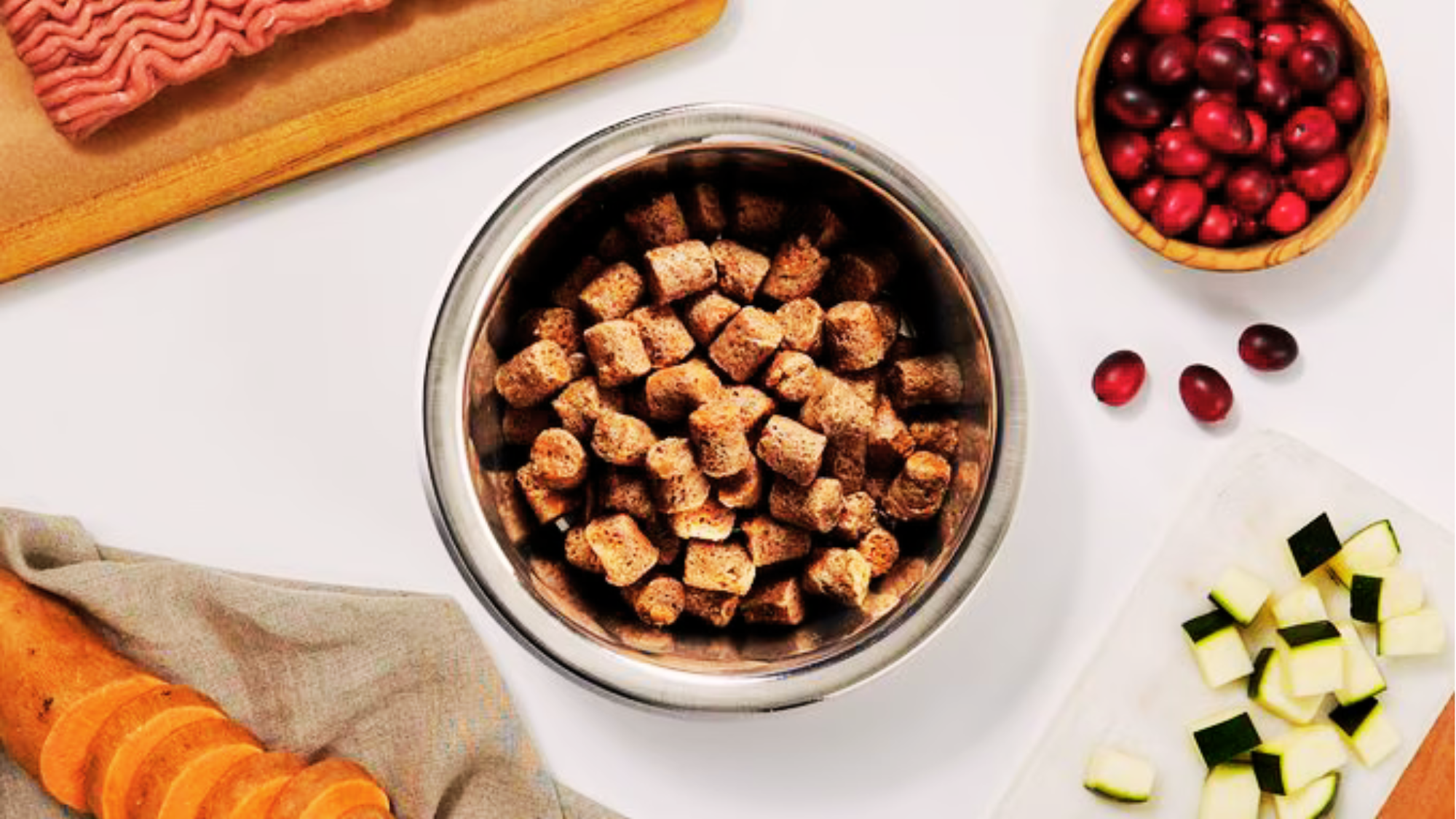| Summary: The best freeze-dried dog food depends on your dog’s needs. High-quality options include Stella & Chewy’s, Primal, Orijen, and Open Farm. Choose formulas with whole meats, no fillers, and added nutrients. Freeze-dried food retains up to 98% of nutrients, supports digestion, and provides a raw diet’s benefits with added convenience. |
Dog owners are constantly searching for the best nutrition for their pets. In recent years, freeze-dried dog food has gained popularity as a high-quality alternative to kibble and canned food. Unlike heavily processed options, freeze-dried food retains most of its original nutrients while offering the convenience of dry food. So, what is the best freeze dried dog food?
Learn if Dachshunds need special collars to provide the right support and comfort for their unique body shape.
Blog Highlights
ToggleWhy Freeze-Dried Dog Food?
Freeze-dried dog food is made by freezing fresh ingredients and then slowly removing moisture through a vacuum process. This method helps maintain the food’s natural flavor, texture, and nutrients without requiring artificial preservatives.
As a result, freeze-dried food is a great choice for pet parents who want to provide a balanced and natural diet without the risks associated with raw feeding. Discover what size collar is best for a French Bulldog puppy to ensure both safety and comfort during their growing stages.
Quick Fix FAQ Guide
| Question | Quick Answer |
| How much freeze-dried food should I feed my dog? | Follow weight-based guidelines (e.g., 1-2 cups for medium dogs). |
| Do I need to add water to freeze-dried food? | Yes, use a 1:1 ratio for rehydration. |
| Is freeze-dried food good for all dogs? | Yes, but portion sizes and formulas vary by age, health, and activity level. |
| Can I mix freeze-dried food with kibble? | Yes, it works as a topper or full meal. |
| How long does freeze-dried dog food last? | Unopened: 2-3 years; Opened: Store in a cool, dry place. |
Why Choose Freeze-Dried Dog Food?
But how much freeze-dried food should you feed your dog? How do you transition your pet to this diet? And what are the best types of freeze-dried dog food available? In this guide, we will cover everything you need to know, including portion sizes, feeding schedules, and key benefits of different types of freeze-dried food.
1. Higher Nutritional Value
One of the biggest reasons pet owners switch to freeze-dried dog food is its superior nutrient retention. Unlike kibble, which is cooked at high temperatures, freeze-dried food maintains up to 98% of its original vitamins and minerals. This means your dog gets more protein, essential fatty acids, and antioxidants with every meal.
Since freeze-dried dog food is often made with whole meats, organ meats, and bones, it provides a rich source of glucosamine and chondroitin, which help maintain joint health. This is particularly beneficial for large breed dogs and senior dogs prone to arthritis.
2. Long Shelf Life and Convenience
Another major advantage of freeze-dried dog food is its long shelf life. Unlike raw food, which must be refrigerated and consumed quickly, freeze-dried food can last up to 2-3 years if stored in a cool, dry place. This makes it a convenient option for busy pet owners or those who travel frequently. Understand if French Bulldogs can wear dog collars and how it affects their neck structure and overall health.
Unlike frozen raw food, freeze-dried meals do not require thawing. You simply add water to rehydrate the food, and it’s ready to serve in 3-5 minutes. This is an excellent solution for those who want the benefits of raw feeding without the inconvenience of handling raw meat.
3. Digestibility and Food Sensitivities
Dogs with food sensitivities often thrive on freeze-dried diets. Since freeze-dried food is minimally processed and free from artificial additives, it is gentler on the digestive system. Many brands also offer limited-ingredient formulas that are free from common allergens like grains, soy, and dairy.
If your dog suffers from diarrhea, vomiting, or excessive itching, switching to a freeze-dried diet with a novel protein source (such as duck or venison) may help. Studies show that dogs fed a raw or freeze-dried diet experience fewer digestive issues and have better stool consistency compared to kibble-fed dogs.
How Much Freeze-Dried Dog Food Should You Feed?
When switching to freeze-dried food, determining the correct portion size is essential. Since freeze-dried food is highly concentrated, dogs require less volume compared to kibble.
Here’s a general guideline based on your dog’s weight:
- Small dogs (5-15 lbs) → ½ – 1 cup per day
- Medium dogs (16-30 lbs) → 1 – 2 cups per day
- Large dogs (31-60 lbs) → 2 – 4 cups per day
- Extra-large dogs (61+ lbs) → 4 – 6 cups per day
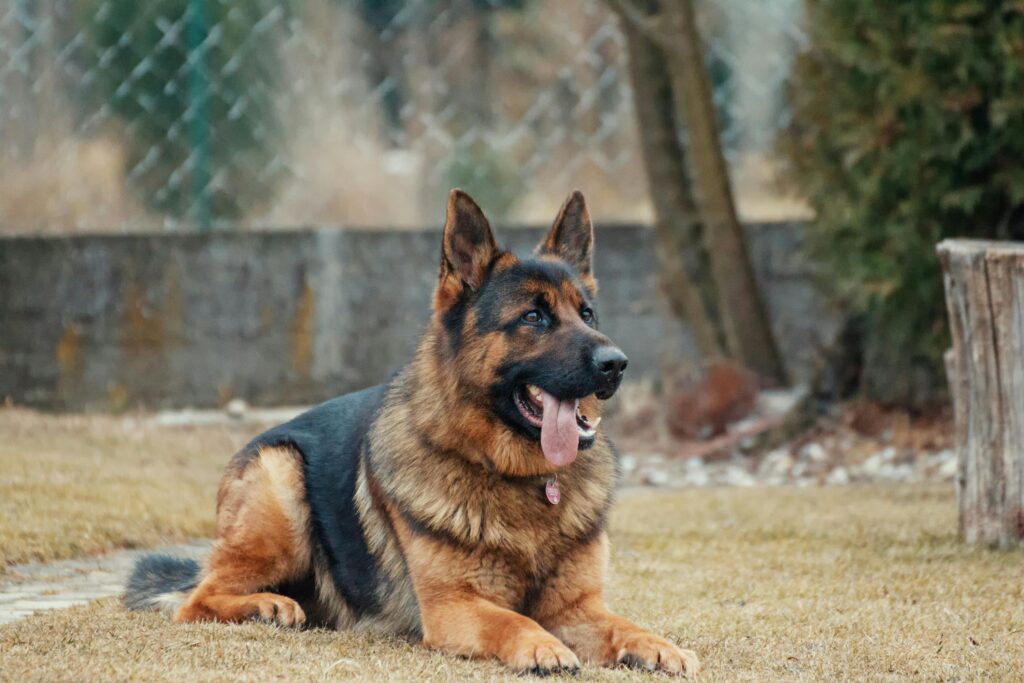
For puppies and active dogs, increase the portion by 25-30% to support their higher energy needs.
When rehydrating freeze-dried food, use a 1:1 ratio of food to water. If your dog prefers a softer texture, you can add slightly more water and let it sit for 5-10 minutes before serving. Explore the best dog collars for French Bulldogs to keep them comfortable while ensuring durability and style.
What is The Best Freeze Dried Dog Food: Types of Freeze-Dried Dog Food
So what is the best freeze dried dog food? Choosing the right freeze-dried dog food depends on your pet’s dietary needs and preferences. Here are ten popular types:
1. Single-Protein Freeze-Dried Dog Food
This type contains only one source of animal protein, such as beef, chicken, or lamb. It is ideal for dogs with food allergies since it reduces the risk of exposure to allergens.
2. Multi-Protein Freeze-Dried Dog Food
Multi-protein diets combine two or more meat sources, such as turkey and duck or beef and fish. This type provides a diverse amino acid profile, which supports muscle development and overall health.
3. Grain-Free Freeze-Dried Dog Food
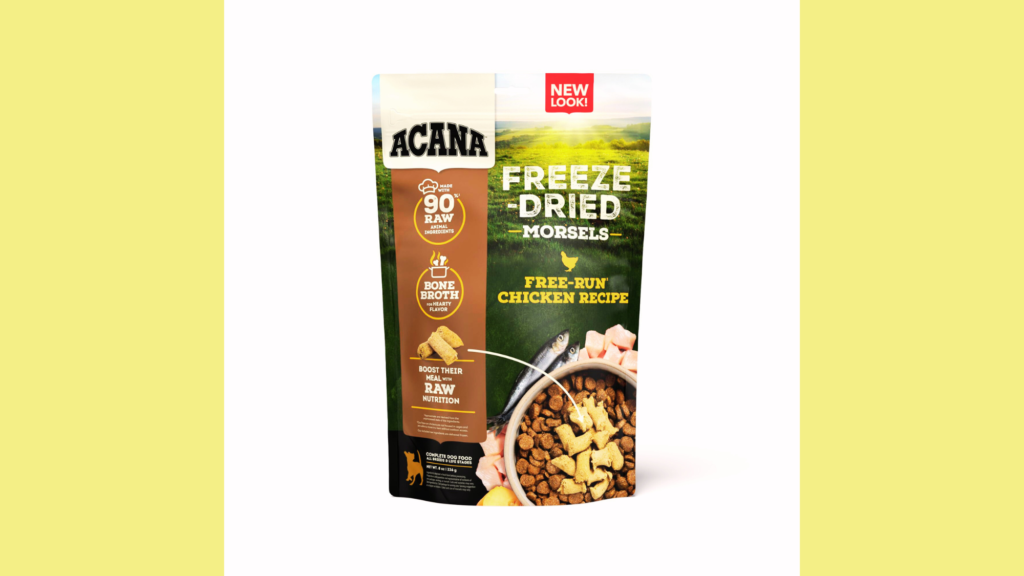
Grain-free formulas exclude wheat, corn, and soy, making them suitable for dogs with grain sensitivities. Instead, they use sweet potatoes, lentils, or chickpeas as carbohydrate sources.
4. Limited-Ingredient Freeze-Dried Dog Food
These diets contain a minimal number of ingredients, often just meat, organs, and a few plant-based components. They are designed for dogs with food intolerances or sensitive stomachs.
5. Freeze-Dried Raw Complete Meals
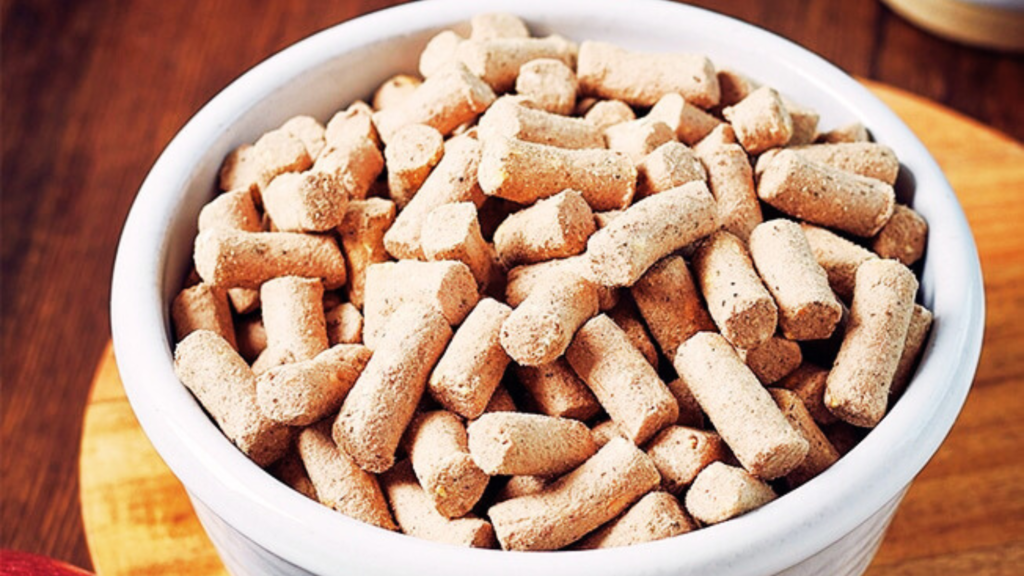
Complete meal formulas contain muscle meat, organs, bones, and vegetables, offering a fully balanced diet. These meals meet AAFCO nutritional standards for all life stages.
6. Freeze-Dried Raw Toppers
Toppers are not meant to replace an entire meal but instead enhance regular kibble. They add extra protein, healthy fats, and natural enzymes to a dog’s diet.
7. Freeze-Dried Dog Food with Superfoods
These foods include ingredients like blueberries, turmeric, and coconut oil, which provide additional antioxidants and anti-inflammatory benefits.
8. Freeze-Dried Puppy Food
Puppy formulas have higher protein (30-40%) and fat (15-20%) content to support growth. They also contain DHA and EPA for brain development.
9. Freeze-Dried Senior Dog Food
Senior-specific food contains lower calories and added joint supplements, such as glucosamine and omega-3 fatty acids, to support aging joints.
10. Freeze-Dried Hypoallergenic Dog Food
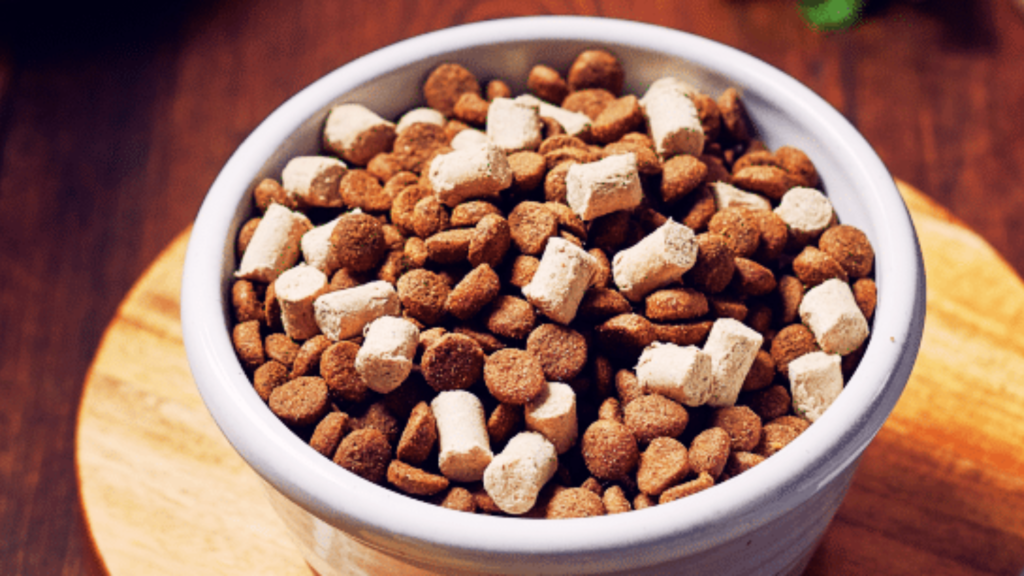
For dogs with severe allergies, these diets use novel proteins like kangaroo or rabbit and exclude common allergens like chicken and beef. Find the best dog collars for Dachshunds that accommodate their long bodies and prevent strain on their necks.
How to Transition Your Dog to Freeze-Dried Food
To avoid digestive upset, transition your dog gradually over 7-10 days:
- Days 1-3 → Mix 25% freeze-dried food with 75% current food
- Days 4-6 → Increase to 50% freeze-dried food, 50% current food
- Days 7-9 → Increase to 75% freeze-dried food, 25% current food
- Day 10+ → Fully transition to 100% freeze-dried food
Monitor your dog’s stool, energy levels, and overall health during the transition. If they experience diarrhea or vomiting, slow down the transition process.
Is Freeze-Dried Dog Food Safe for All Dogs?
When considering freeze-dried dog food, one of the biggest concerns among pet owners is whether it is safe for all dogs. While freeze-dried food offers superior nutrition, digestibility, and convenience, it may not be the best option for every dog. Factors like age, health conditions, activity level, and dietary sensitivities play a crucial role in determining whether this diet is suitable.
1. Puppies and Freeze-Dried Food: A Good Match?

Puppies require a higher caloric intake and specific nutrients to support their rapid growth and development. Freeze-dried food can be an excellent choice for puppies, but it is essential to select a formula designed for growth. Puppies need a diet rich in protein (30-40%) and healthy fats (15-20%) to support their developing muscles, bones, and brain.
A well-balanced freeze-dried puppy formula should also contain DHA (Docosahexaenoic Acid) and EPA (Eicosapentaenoic Acid)—two essential omega-3 fatty acids that promote cognitive development.
These nutrients are commonly found in fish-based freeze-dried meals. However, pet owners should be cautious about portion sizes. Puppies have smaller stomachs and higher energy demands, so they require smaller, more frequent meals (3-4 times per day) rather than large portions all at once.
2. Senior Dogs and Freeze-Dried Diets
Senior dogs have different dietary needs than younger dogs, and freeze-dried food can be an excellent option, provided it meets their nutritional requirements. As dogs age, their metabolism slows down, which means they require fewer calories but more joint-supporting nutrients like glucosamine, chondroitin, and omega-3 fatty acids.
A senior dog’s diet should contain high-quality proteins (around 25-30%) to maintain muscle mass while keeping fat levels moderate (10-15%) to prevent excessive weight gain. Many senior-specific freeze-dried formulas include added antioxidants from blueberries, cranberries, or turmeric, which can help support cognitive function and immune health.
Additionally, senior dogs often have more sensitive digestive systems, making the gentle processing of freeze-dried food a great alternative to hard kibble, which can be difficult to chew. Get insights into what is best for Dachshunds: a collar or harness for their safety, comfort, and health during walks.
3. Freeze-Dried Food for Dogs with Allergies or Sensitivities
Dogs with food allergies or sensitivities often experience digestive issues, itchy skin, ear infections, or chronic inflammation. Freeze-dried food can be beneficial because it typically contains fewer artificial ingredients, preservatives, and fillers that commonly trigger allergic reactions.
A limited-ingredient freeze-dried diet with a novel protein source—such as duck, rabbit, or venison—is often recommended for dogs with food intolerances. These proteins are less likely to cause allergic reactions compared to common proteins like beef and chicken.
Many freeze-dried formulas are also grain-free, making them suitable for dogs with grain sensitivities. However, it is essential to read the ingredient list carefully and consult a veterinarian if a dog has a history of severe allergies.
4. Is Freeze-Dried Dog Food Safe for Dogs with Kidney or Liver Disease?
Dogs with kidney or liver disease often require special diets with reduced protein and phosphorus levels to prevent excessive strain on these organs. Since most freeze-dried foods are high in protein (30-40% or more), they may not be suitable for dogs with these conditions. Instead, these dogs may need a prescription diet formulated for kidney or liver support.
For dogs with mild kidney concerns, some freeze-dried formulas with moderate protein levels (20-25%) and higher moisture content may be an option, but only under veterinary supervision. Adding extra water when rehydrating the food can help support kidney function by promoting hydration and reducing the workload on the kidneys.
5. Can Overweight Dogs Eat Freeze-Dried Food?
Obesity is a growing concern in dogs, with over 50% of dogs in the U.S. being overweight or obese. While freeze-dried food is nutrient-dense, it is also calorie-dense due to the removal of water. This means that portion control is critical when feeding overweight dogs.
To manage weight, look for low-fat freeze-dried formulas (10-12% fat) and monitor portion sizes carefully. Using a kitchen scale to weigh each meal is recommended, as feeding too much freeze-dried food can lead to excess calorie intake. Additionally, incorporating fresh vegetables, such as green beans or carrots, into meals can add bulk without extra calories, helping a dog feel full while maintaining a healthy weight.
Final Thoughts: Which Freeze-Dried Dog Food Is Best?
The best freeze-dried dog food depends on your dog’s specific needs. Whether you choose a single-protein, multi-protein, or grain-free formula, the key is selecting a high-quality brand that uses real, whole ingredients without artificial additives. Hope so, now you know what is the best freeze dried dog food.
Freeze-dried dog food provides up to 98% nutrient retention, making it one of the healthiest options available. With proper portion control and gradual transitioning, it can significantly improve your dog’s digestion, energy levels, and overall well-being.
By choosing a premium freeze-dried diet, you ensure your furry friend gets the best possible nutrition while enjoying a diet that is as close to nature as possible. To discover what activities bring joy to Australian Cattle Dogs, check out this detailed guide on What Do Australian Cattle Dogs Love.

